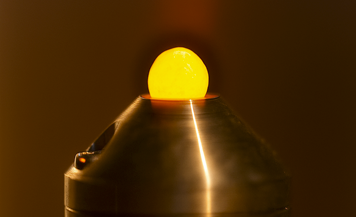First users on SHARPER, ILL-CRG

From left to right : Igor CALSINA ESTANAN (CEA Iramis, Laboratoire Leon Brillouin), Andreas MEYER (ILL), Quentin BERROD (Univ. Grenoble Alpes, CNRS, CEA, Grenoble INP, IRIG, SyMMES, Grenoble, France), Jean-Marc ZANOTTI (CEA Iramis, Laboratoire Leon Brillouin), Phillip ECKSTEIN (DLR/ILL). Credits : V.Guerard - ILL
Last week, the very first team of users were performing experiments on the SHARPER instrument at the ILL.
The first measurements user measurements on SHARPER were performed with PhD student Phillip Eckstein, working on a joint PhD project between the ILL and the Institute of Frontier Materials of the German Aerospace Center (DLR). They concerned the study of atomic dynamics in a glass-forming viscous liquid over a broad momentum transfer to unveil the relation between structural relaxation and diffusive transport of mass, and to test the validity of established Maxwell and Stokes-Einstein relations.
One of the novelties in this experiment was the new ADL-designed, aerodynamic levitator for neutron scattering. This plug-and-play set-up had already proven its capabilities in diffraction (structure) experiments on D20 and XtremeD. The new system enabled containerless measurements on structure and dynamics on molten metals, oxides and ceramics
SHARPER is an inelastic spectrometer using the time-of-flight technique, and indeed the highest-flux crystal time-of-flight spectrometer with time focussing. The instrument is designed to access dynamic modes in condensed matter by measuring the energy exchange between a monochromatic neutron beam and the sample.
SHARPER came online during the second 2024 reactor cycle (which ran from 16 May to 9 June). SHARPER was built and is operated at the ILL by the Léon Brillouin Laboratory (Saclay, France) as a CRG (Collaborating Research Group) instrument.
The original instrument SHARP (Spectromètre Hybride Alpes Région Parisienne, former IN6) was upgraded in the framework of ILL’s Endurance programme through the SHARP+ project. The instrument has also been moved (through the roof of one of ILL’s guide halls) to a new site at the end of the new H15 neutron guide, designed and engineered at the ILL, which is the most complex neutron guide system ever realised.
Andreas Meyer, Phillip Eckstein's supervisor, recalls the 'more than 100 nights' spent on IN6 nearly 30 year ago, as well as the back-of-the-envelope drawings done with Helmut Schober on how to increase the flux by a factor of 10, which are now a reality.
Previous articles : Update on SHARPER (22/07/2024) & From SHARP to SHARPER (26/04/2024)



